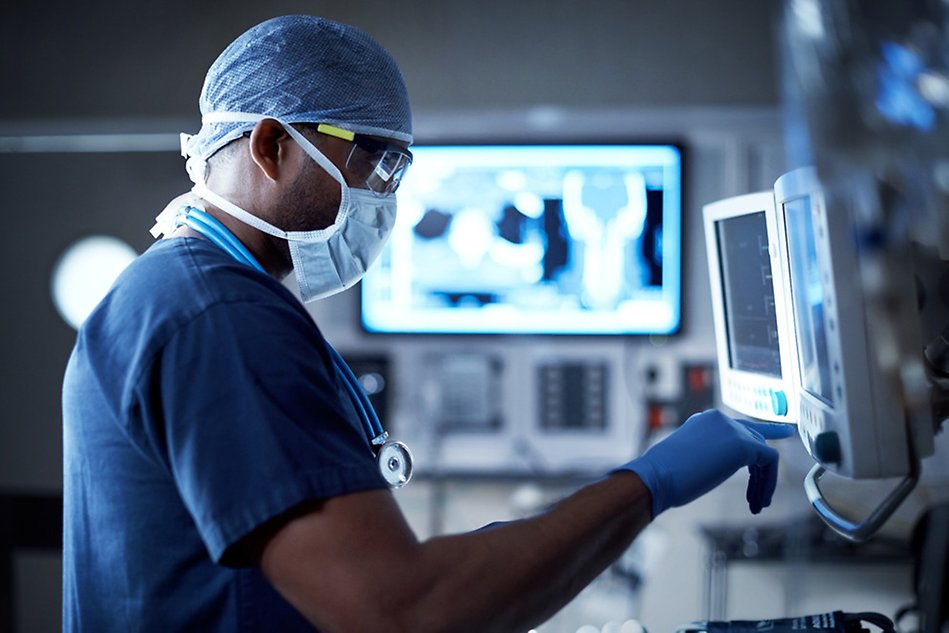Preparation determines AI quality in complex surgeries
Advanced technology and AI are becoming increasingly integrated in healthcare, and it takes time to interpret and assess AI-generated results. New research from Halmstad University on hybrid operating theatres points to a fact that is often overlooked. It takes as much work to create the data and settings on which AI builds its results, as it does to interpret the results afterwards.

“The preparation and groundwork was extensive and crucial for the smooth functioning of the technology during the operations."
Daniel Tyskbo, Associate Senior Lecturer
Advanced technologies and AI are impacting more and more medical decisions and the daily work of healthcare professionals. Previous research has mainly focused on how healthcare professionals need to interpret and assess AI-generated results. Clinical experts must rely heavily on their judgement to determine whether results are relevant and reliable. Daniel Tyskbo, Associate Senior Lecturer in Health Innovation at Halmstad University, is one of the researchers behind a study on AI in hybrid operating theatres.
“The study shows something that is often overlooked, namely that it takes just as much work before the actual use of AI – calibrating, configuring and preparing the algorithms and technology for each unique situation – to create useful AI-generated results. The advanced imaging technologies do not produce ready-made answers, but require medical teams to actively adjust, calibrate and customise the technology to ensure that the images are reliable and meaningful in a specific surgical situation”, says Daniel Tyskbo.
Hybrid operating theatres
The researchers investigated how advanced medical imaging technologies are used in modern operating theatres to support surgeons and radiologists in complex procedures. Over the course of five years, the researchers interviewed and observed healthcare professionals, tracking how healthcare teams work with imaging technologies in hybrid operating theatres, where X-ray and other advanced examinations can be performed during surgery. Combining X-rays and the operation itself poses new challenges. It involves different professions that were previously separated, as well as technical and physical factors such as space and sterilisation. The researchers also followed the healthcare teams before the operations, during training, practice sessions and meetings.
“The preparation and groundwork was extensive and crucial for the smooth functioning of the technology during the operations. Everyone was driven by the common goal of providing better care with higher precision and making things better for patients.”
Constantly emerging
Knowledge of how to interpret not only the results of AI, but also the insight that data comes from somewhere, can play a crucial role in an increasingly digitised healthcare system”, says Daniel Tyskbo.
Technology emerges and is created as it is used:
“Technologies and algorithms are taken for granted by many to be quite stable. We argue that they are constantly emerging and need to be adapted to the experts who use them in different contexts. In this situation, the conditions, interpretation and negotiation determine how good the images are and whether they can be used during the operation, and this can of course be absolutely crucial for the outcome of the operation.”
Text: Kristina Rörström
Photo: Istock
More about the research
In addition to Daniel Tyskbo from Halmstad University, Kajsa Lindberg and Alexander Styhre, both at the University of Gothenburg, are behind the study.
The research is based on a longitudinal and ethnographically inspired study of medical teams at a Swedish university hospital, where the researchers conducted 116 interviews and 349 hours of field observations in operating theatres equipped with the latest imaging technologies (such as Robotic X-ray and intraoperative MRI). The researchers followed healthcare professionals in their daily work, observed how they adapted the technology during operations, and analysed how the experts jointly developed methods to produce and interpret images in real time. They also interviewed suppliers and technology specialists to understand how these advanced systems are designed and implemented in healthcare.
The researchers call these technologies “epistemic technologies” (epistemology is the study of knowledge) because they are used not only to store or facilitate data, but also to interpret and influence how new knowledge is created in medical practice.
The article is published in the scientific journal Organization Studies, which is highly ranked on the internationally recognised ABS/AJG (Academic Journal Guide) list and is also included in the prestigious Financial Times top 50 list of the world's leading scientific journals in organisation and management.


